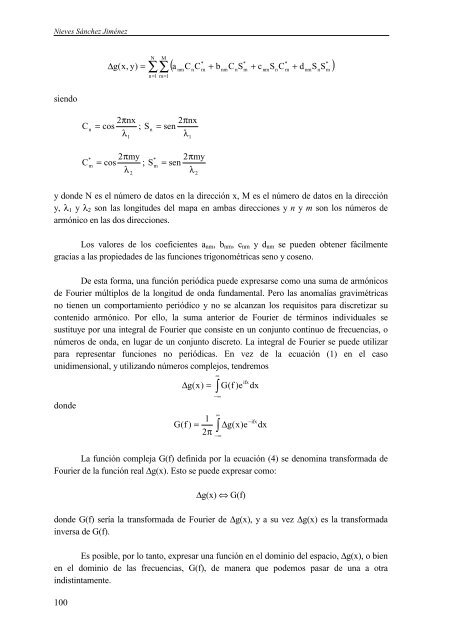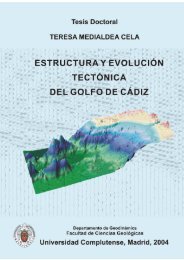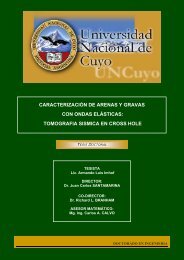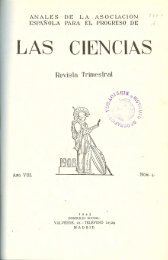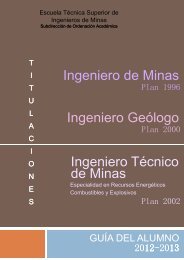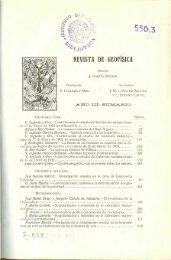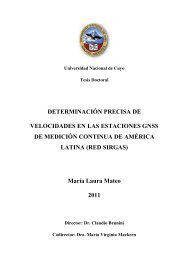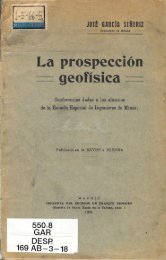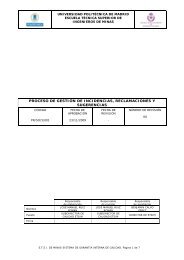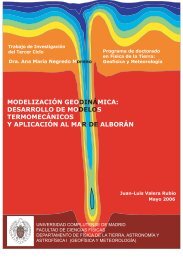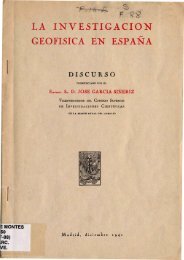estructura gravimétrica y magnética de la corteza del suroeste ...
estructura gravimétrica y magnética de la corteza del suroeste ...
estructura gravimétrica y magnética de la corteza del suroeste ...
You also want an ePaper? Increase the reach of your titles
YUMPU automatically turns print PDFs into web optimized ePapers that Google loves.
Nieves Sánchez Jiménez<br />
siendo<br />
100<br />
C<br />
C<br />
n<br />
*<br />
m<br />
∆g<br />
( x,<br />
y)<br />
=<br />
2πnx<br />
= cos ; S<br />
λ<br />
2πmy<br />
= cos ; S<br />
λ<br />
1<br />
2<br />
N M<br />
*<br />
*<br />
*<br />
*<br />
∑∑(<br />
a nmC<br />
nC<br />
m + bnmC<br />
nSm<br />
+ c nmS<br />
nC<br />
m + d nmS<br />
nSm<br />
)<br />
n=<br />
1 m=<br />
1<br />
n<br />
2πnx<br />
= sen<br />
λ<br />
*<br />
m<br />
1<br />
2πmy<br />
= sen<br />
λ<br />
2<br />
y don<strong>de</strong> N es el número <strong>de</strong> datos en <strong>la</strong> dirección x, M es el número <strong>de</strong> datos en <strong>la</strong> dirección<br />
y, λ1 y λ2 son <strong>la</strong>s longitu<strong>de</strong>s <strong>de</strong>l mapa en ambas direcciones y n y m son los números <strong>de</strong><br />
armónico en <strong>la</strong>s dos direcciones.<br />
Los valores <strong>de</strong> los coeficientes anm, bnm, cnm y dnm se pue<strong>de</strong>n obtener fácilmente<br />
gracias a <strong>la</strong>s propieda<strong>de</strong>s <strong>de</strong> <strong>la</strong>s funciones trigonométricas seno y coseno.<br />
De esta forma, una función periódica pue<strong>de</strong> expresarse como una suma <strong>de</strong> armónicos<br />
<strong>de</strong> Fourier múltiplos <strong>de</strong> <strong>la</strong> longitud <strong>de</strong> onda fundamental. Pero <strong>la</strong>s anomalías <strong>gravimétrica</strong>s<br />
no tienen un comportamiento periódico y no se alcanzan los requisitos para discretizar su<br />
contenido armónico. Por ello, <strong>la</strong> suma anterior <strong>de</strong> Fourier <strong>de</strong> términos individuales se<br />
sustituye por una integral <strong>de</strong> Fourier que consiste en un conjunto continuo <strong>de</strong> frecuencias, o<br />
números <strong>de</strong> onda, en lugar <strong>de</strong> un conjunto discreto. La integral <strong>de</strong> Fourier se pue<strong>de</strong> utilizar<br />
para representar funciones no periódicas. En vez <strong>de</strong> <strong>la</strong> ecuación (1) en el caso<br />
unidimensional, y utilizando números complejos, tendremos<br />
don<strong>de</strong><br />
∞<br />
∫<br />
−∞<br />
ifx<br />
∆g( x)<br />
= G(<br />
f ) e dx<br />
G(<br />
f )<br />
1<br />
∞<br />
−ifx<br />
= ∫ ∆g(<br />
x)<br />
e dx<br />
2π<br />
−∞<br />
La función compleja G(f) <strong>de</strong>finida por <strong>la</strong> ecuación (4) se <strong>de</strong>nomina transformada <strong>de</strong><br />
Fourier <strong>de</strong> <strong>la</strong> función real ∆g(x). Esto se pue<strong>de</strong> expresar como:<br />
∆g(x) ⇔ G(f)<br />
don<strong>de</strong> G(f) sería <strong>la</strong> transformada <strong>de</strong> Fourier <strong>de</strong> ∆g(x), y a su vez ∆g(x) es <strong>la</strong> transformada<br />
inversa <strong>de</strong> G(f).<br />
Es posible, por lo tanto, expresar una función en el dominio <strong>de</strong>l espacio, ∆g(x), o bien<br />
en el dominio <strong>de</strong> <strong>la</strong>s frecuencias, G(f), <strong>de</strong> manera que po<strong>de</strong>mos pasar <strong>de</strong> una a otra<br />
indistintamente.


